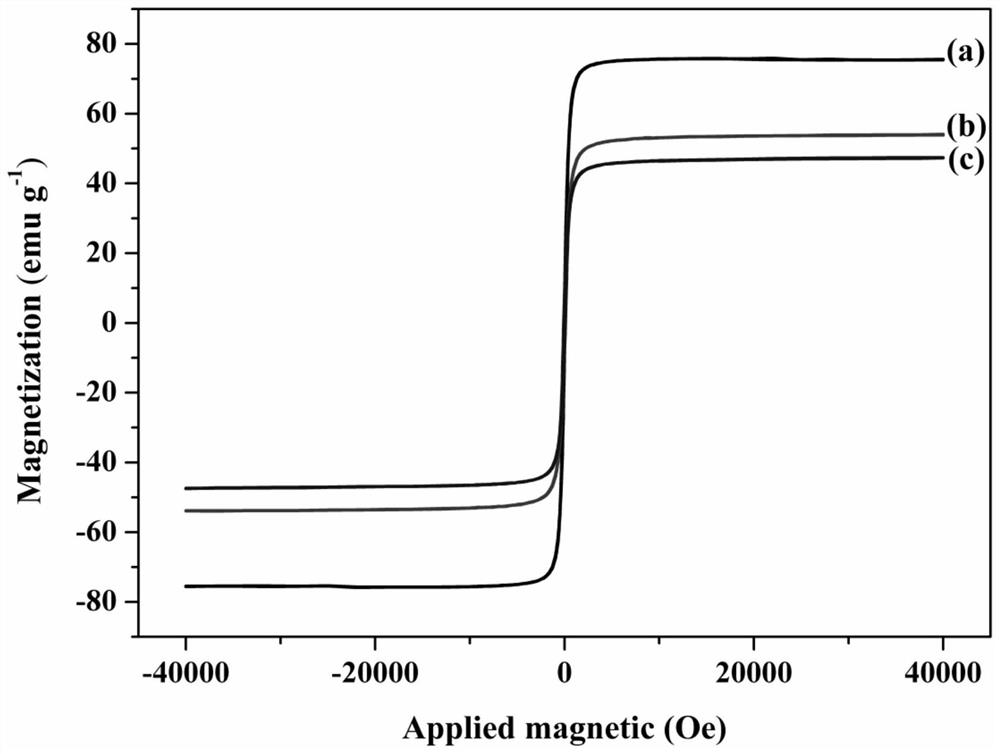Self-assembled amino acid derivative functionalized magnetic-carbon nanotube composite material and its preparation method and application
A composite material and carbon nanotube technology, which is used in the preparation of cyanide reaction, chemical instruments and methods, preparation of organic compounds, etc., can solve the problems of limited application scope, difficult solid-liquid separation, etc., and achieves increased load capacity and difficult separation. , to achieve the effect of controllable design
- Summary
- Abstract
- Description
- Claims
- Application Information
AI Technical Summary
Problems solved by technology
Method used
Image
Examples
Embodiment 1
[0025] Example 1—Preparation method of self-assembled hexadecyl-L hydroxyproline functionalized magnetic-carbon nanotube composite material
[0026] (1) Magnetic Fe 3 o 4 Preparation of / MWCNTs composites
[0027] Weigh 1.35g FeCl 3 ·6H 2 O was added to 35 mL of ethylene glycol solution. Then, 3.6 g of anhydrous sodium acetate, 1.0 g of polyethylene glycol and 0.2 g of carboxylated multi-walled carbon nanotubes were sequentially added, and ultrasonically dispersed for 0.5 h. Add 6 mL of hexamethylenediamine, continue mechanical stirring for 0.5 h, then transfer the liquid to a sealed stainless steel hydrothermal reaction kettle with a polytetrafluoroethylene liner, and heat to 220 ° C for 8 h. The obtained product was washed 6 times with deionized water and absolute ethanol, and dried under vacuum at 80 °C to prepare magnetic Fe 3 o 4 / MWCNTs composites.
[0028] (2) Preparation of self-assembled amino acid derivative functionalized magnetic-carbon nanotube composites ...
Embodiment 2
[0031] Embodiment 2—Structural characterization of magnetic materials
[0032] (1) Shape and size characterization
[0033] The particle size and morphology of the prepared magnetic particles were observed with a Tecnai G2F20 transmission electron microscope (FEI, USA). figure 1 is magnetic Fe 3 o 4 Nanoparticles and Magnetic Fe 3 o 4 / MWCNTs-Hyp composite transmission electron micrographs. From figure 1 (a) It can be seen that the magnetic Fe without multi-walled carbon nanotubes 3 o 4 Nanoparticles are petal-like, with a particle size of 80±5nm; figure 1 (b) shows magnetic Fe 3 o 4 Magnetic Fe in / MWCNTs-Hyp composites 3 o 4 The nanoparticles are evenly deposited on the carbon nanotubes, with a particle size of 60±5nm. After the carbon nanotubes are added, the steric hindrance increases, resulting in restricted growth of crystal nuclei, making the magnetic Fe 3 o 4 The particle size of the nanoparticles is reduced.
[0034] (2) Crystal form characterization
...
Embodiment 3
[0040] Example 3—Self-assembled hexadecyl-L-hydroxyproline functionalized magnetic-carbon nanotube composite material for splitting amino acids
[0041] The self-assembled amino acid derivative functionalized magnetic-carbon nanotube composite material prepared by the technical scheme of the present invention is used to resolve amino acid chiral isomers. With magnetic Fe 3 o 4 / MWCNTs-Hyp composite material is used as a chiral adsorbent to resolve amino acid enantiomers in solution to test its chiral resolution ability, in which the functional group L-hydroxyproline is the chiral recognition agent Ligand. The chiral ligand coordinates with the D- and L-enantiomers of the amino acid respectively through the central metal ion to form a complex of two diastereoisomers, and the stability of the two complexes is different , thus achieving chiral separation.
[0042] DL-phenylalanine was selected as the analyte, and the resolution effect was analyzed by HPLC. Use acetonitrile-wat...
PUM
| Property | Measurement | Unit |
|---|---|---|
| particle diameter | aaaaa | aaaaa |
Abstract
Description
Claims
Application Information
 Login to View More
Login to View More - R&D
- Intellectual Property
- Life Sciences
- Materials
- Tech Scout
- Unparalleled Data Quality
- Higher Quality Content
- 60% Fewer Hallucinations
Browse by: Latest US Patents, China's latest patents, Technical Efficacy Thesaurus, Application Domain, Technology Topic, Popular Technical Reports.
© 2025 PatSnap. All rights reserved.Legal|Privacy policy|Modern Slavery Act Transparency Statement|Sitemap|About US| Contact US: help@patsnap.com



